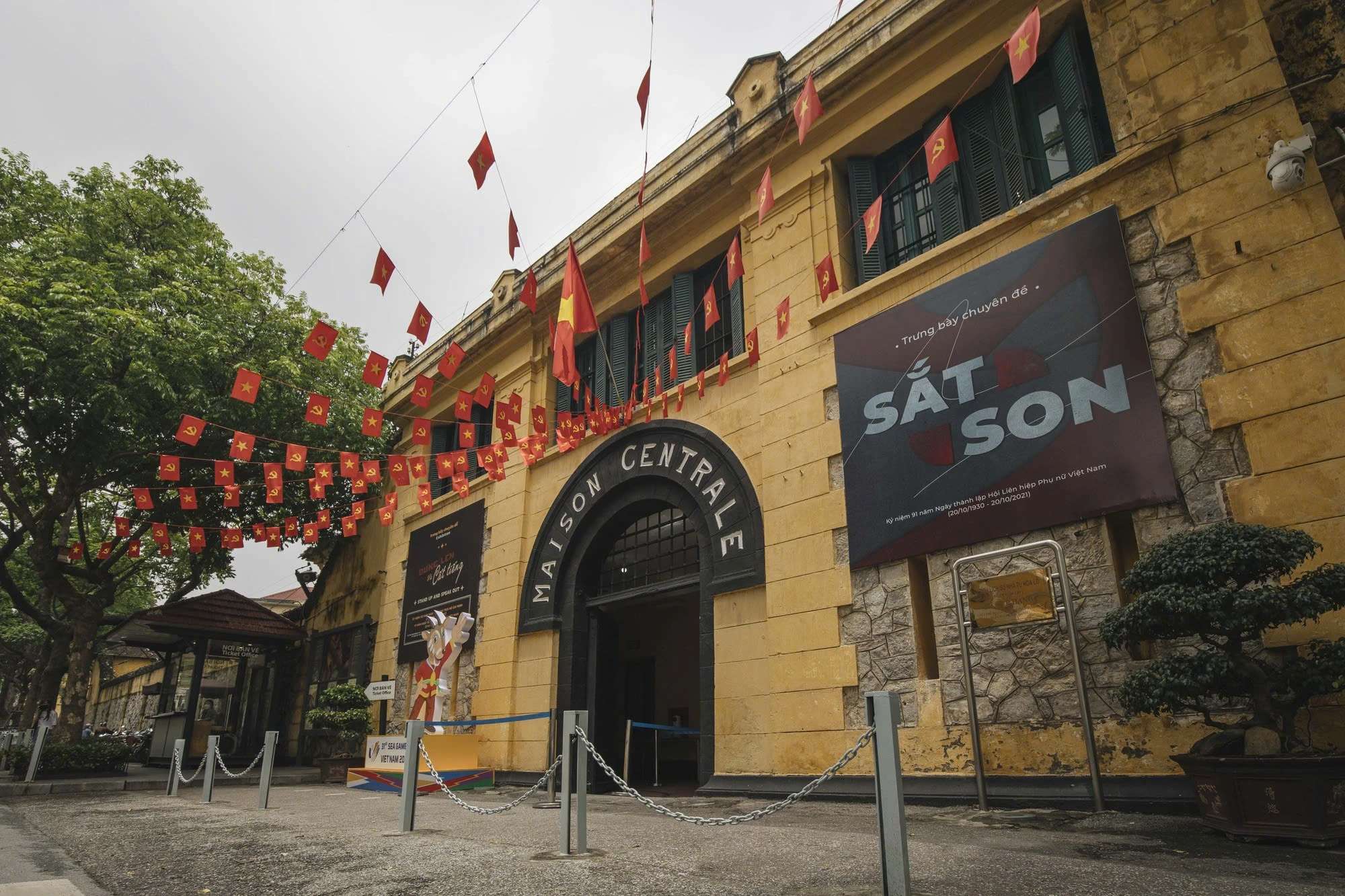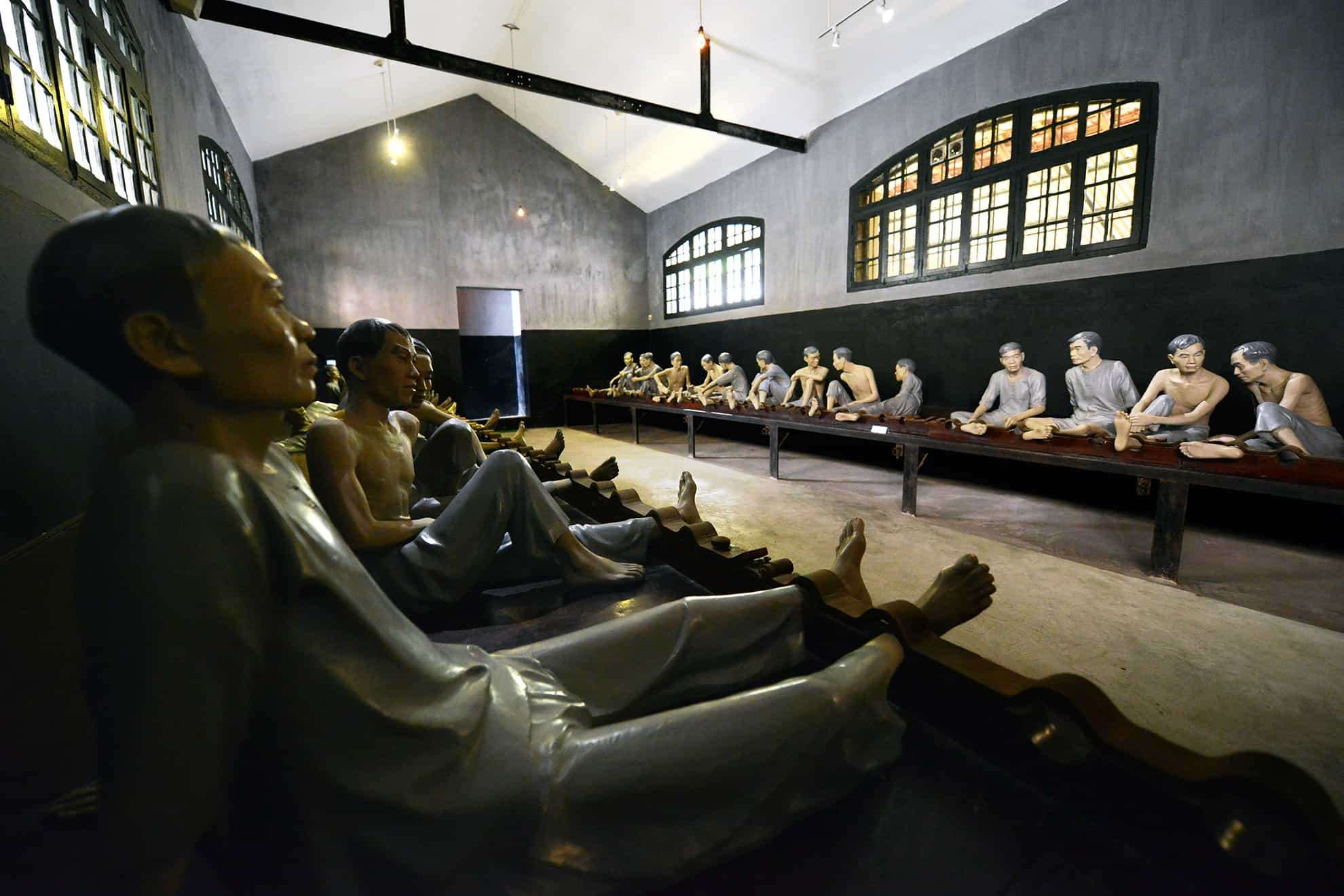Hoa Lo Prison, also known as Maison Centrale, was built by the French colonialists to detain and torture Vietnamese revolutionaries and patriotic leaders. After its original use was discontinued, the prison was preserved and reconstructed into a unique cultural and historical attraction in Hanoi. Keep reading to discover the stories hidden behind this “hell on earth.”
Hoa Lo Prison is one of Hanoi’s most famous historical relics, bearing witness to the hardships endured by thousands of Vietnamese soldiers during the resistance against French colonial rule. If you visit Hanoi, don’t miss the opportunity to stop by and honor the heroes who sacrificed their lives for national freedom.

- Where is Hoa Lo Prison? Directions & Location
Address: No. 1, Hoa Lo Street, Hoan Kiem District, Hanoi
Located in central Hanoi, Hoa Lo Prison is close to many other major tourist attractions. You can easily reach the site by personal vehicles or public transportation.
If you start from Hoan Kiem Lake, follow Le Thai To Street toward Hang Trong, then continue on Ba Trieu Street. Turn right onto Hai Ba Trung Street, go straight for about 500 meters, and then turn left onto Hoa Lo Street. The prison is located at number 1 on this street.
For a budget-friendly option, public buses are a great choice. You can take bus routes 32, 02, 38, or 41, all of which have stops near the site.
- Opening Hours & Entrance Fees
- Opening hours: Daily from 8:00 AM to 5:00 PM (including holidays).
- Ticket price: 30,000 VND per person.
Free entry is available for:
- Children under 15
- Individuals with severe disabilities
- Members of the Veterans’ Association or Resistance Forces
- People with meritorious services to the revolution
50% discount for:
- Students (with valid student ID)
- Individuals with moderate disabilities
- Vietnamese citizens aged 60 and above
- People under special social policies
Audio guide rental: 50,000 VND/headset
- What to Know About Hoa Lo Prison
3.1. The History of Hoa Lo Prison
To suppress growing resistance movements in late 19th-century Vietnam, the French colonial government strengthened its repressive system by enhancing the police force, legal institutions, and building prisons. In 1896, on land that once belonged to Phu Khanh Village in Tho Xuong District, the French built Hoa Lo Prison—one of the largest prisons in Indochina at the time.
The site was once home to a traditional ceramic-making village. However, the French turned it into a place of imprisonment and suffering, stripping thousands of Vietnamese patriots and revolutionaries of their physical and mental freedom.
Despite the brutal conditions, prisoners remained resilient and committed to the revolutionary cause. Hoa Lo became a “school” for revolutionary theory and a base for organizing daring prison escapes.
Notable figures imprisoned here include Phan Boi Chau, Nguyen Quyen, Nguyen Luong Bang, Luong Van Can, Ho Tung Mau, and five former General Secretaries of the Communist Party of Vietnam: Nguyen Van Cu, Le Duan, Truong Chinh, Do Muoi, and Nguyen Van Linh.

After Northern Vietnam gained independence, the government repurposed the prison to detain law offenders. From August 5, 1964, to March 31, 1973, Hoa Lo was also used to detain downed American pilots, including those captured during bombing campaigns in North Vietnam.
In 1993, the Vietnamese government decided to preserve the southeastern part of the prison complex, restoring it as a historical site. Today, Hoa Lo includes a memorial to patriotic soldiers who bravely gave their lives for national independence and freedom.
3.2. The Giant Guillotine – A Symbol of Terror
Inside Hoa Lo Prison stands a guillotine, an execution device invented by French doctor Guillotin. It was considered a “humane” alternative to medieval execution methods.
The guillotine consists of:
- A wooden board where the prisoner is laid, head inserted into a circular slot
- A nearly 4-meter-high iron frame guiding the steel blade
- A sharp, angled blade weighing around 60 kg
When triggered, the blade drops rapidly, decapitating the prisoner. The head falls into a metal container while the body is discarded into a bamboo basket.
3.3. The Sentimental Almond Tree – A Living Witness
According to former political prisoners, the almond tree in the courtyard was planted before 1930 by inmates assigned to labor outside the courthouse. They collected wild saplings and planted them inside the prison yard.
Over time, the tree became a symbol of solidarity. Political prisoners gathered under it to breathe fresh air and discuss resistance strategies.
Its trunk became a silent witness to their daily lives, dreams, ideals, and beliefs. The tree even served as a secret mailbox for smuggling revolutionary documents and messages.
3.4. The Cachot – Dungeon Within a Dungeon
The cachot, or dark cells, were extremely confined—just 4m²—and painted entirely black. These cells had no windows or ventilation, creating an oppressive, tomb-like atmosphere.
The cement beds were angled so prisoners’ heads were lower than their bodies, causing blood to rush to the head. The French used the cachot to punish those who resisted, led protests, or attempted escape. Even Truong Chinh was once locked here for organizing a rally inside the prison to commemorate International Labor Day.
- Hoa Lo Prison Tours
Visitors can choose between day tours and night tours, depending on personal preference and time availability. Each offers a different experience, and it’s recommended to join both for a more comprehensive understanding.
4.1. Day Tour
Daytime tours cost 30,000 VND per person. Visitors can rent headsets to hear recorded stories of former inmates. Each exhibit and artifact is also accompanied by detailed information panels.
The tour leads you through each section of the prison—from dimly lit corridors to completely dark cells. The personal items and clothing of prisoners, combined with the narration, offer a chilling look at the brutalities endured under colonial rule.
4.2. Night Tour – “Sacred Night”
To deepen public understanding of Vietnam’s wartime suffering, Hoa Lo offers a theatrical night tour titled “Sacred Night.”
Through a combination of lighting, sound effects, and live acting, this tour recreates the courageous resistance of Vietnamese soldiers. It provides an immersive, emotional experience highlighting their fight for peace and democracy.
Participants also receive unique souvenirs such as tea, jelly, or cakes made from the leaves of the last remaining almond tree in the prison yard.
Ticket price: 300,000 VND/person.
Tour organizers also provide group photos and videos as keepsakes.
- Tourist Attractions Near Hoa Lo Prison
Since Hoa Lo is located near many iconic Hanoi landmarks, visitors can easily plan their itinerary to include:
- St. Joseph’s Cathedral – 850m away
- Hoan Kiem Lake – 1.1km away
- Temple of Literature – 1.3km away
- Tran Quoc Pagoda – 4.4km away
